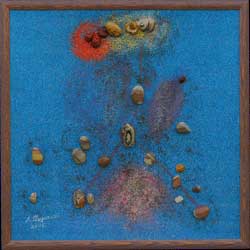|
|
Cancer ( Latin: crab, symbol , Unicode ♋) is one of the twelve constellations of the zodiac. Cancer is small and dim, and to many it does not resemble a crab. It lies between Gemini to the west and Leo to the east, Lynx to the north and Canis Minor and Hydra to the south. Planetary system 55 Cnc is a quintruple planet system with four gas giants and one terrestrial planet. Notable deep sky objects Cancer is the best noted among stargazers as the home of Praesepe (Messier 44), an open cluster also called the Beehive Cluster or the Gate of Men, which contains the star ε Cancri. The smaller, denser open cluster Messier 67 can be found here as well. History Cancer, the Crab, plays a minor role in the Twelve Labors of Hercules. While Hercules was busy fighting the multi-headed monster, Hydra, the goddess Hera, who did not like Hercules, sent the Crab to distract him. Cancer grabbed onto the hero's toe with its claws, but barely breaking the rhythm of his great battle with Hydra, Hercules crushed the crab with his foot. Hera, grateful for the little crustacean's heroic but pitiful effort, gave it a place in the sky. The crab did not win, so the gods didn't give the crab bright stars. Named Stars Etymology The early Sanskrit name of this constellation was Karka and Karkata, in Telugu "Karkatakam", Kannada "Karkataka" or "Kataka" , Tamil Karkatan, and the [[Sinhaljfg ese language|Sinhalese]] Kagthaca.The later Hindus knew it as Kulira, from Κολουρος (Koloyros), the term originated by Proclus. Aratus called it Καρκινος (Karkinos), which Hipparchus and Ptolemy followed, the Carcinus of the Alfonsine tables being Latinized form of the Greek word. Eratosthenes extended this as Καρκινος, Ονοι, και Φατνη: the Crab, Asses, and Crib. Litoreus, Shore-inhabiting, is from Manilius and Ovid. Astacus and Cammarus appear with various classic writers. Nepa is from Cicero's De Finibus and the works of Columella, Plautus, and Varro - all signifying Crab, Lobster, or Scorpion. Kircher said that in Coptic Egypt it was Κλαρια, the Bestia seu Statio Typhonis, the Power of Darkness. Jérôme Lalande identified this with Anubis, one of the Egyptian divinities commonly associated with Sirius. Symbol The modern symbol for Cancer is the crab, but it has been represented with various types of creatures, usually those live in the water, and always those with an exoskeleton. In the Egyptian records of about 2000 BC it was described as Scarabaeus (Scarab), the sacred emblem of immortality, although Peter Jensen claimed this sign had been a tortoise in Babylonia, and that it was so figured there and in Egypt 4000 BC. In the 12th century, an illustrated astronomical manuscript shows it as a water beetle. Albumasar writes of this sign in the work published in 1489 as a large crayfish. Bartschtshitius and Stanislaus Lubienitzki, in the 17th century, described it as a lobster. Mythology As the constellation vaguely resembles a crab, it may, together with the Hydra constellation, form the basis of the myth of the Lernaean Hydra, one of The Twelve Labours of Hercules, with which it is associated.Many people debate whether its a crab or lobster. Cancer is said to have been the place for the Akkadian Sun of the South, perhaps from its position at the winter solstice in very remote antiquity. But afterwards it was associated with the fourth month Duzu (June-July in the modern western calendar), and was known as the Northern Gate of Sun. Showing but few stars, and its lucida being less than a 4th-magnitude, it was often considered "Dark Sign", quaintly described as black and without eyes. Dante, alluding to this faintness and position of heavens, wrote in Paradiso: Thereafterward a light among them brightened, Astrology The Western astrological sign Cancer of the tropical zodiac (June 21 - July 22) differs from the astronomical constellation and the Hindu astrological sign of the sidereal zodiac (July 21–August 9). In Greek mythology this crab was the one that Hercules faced right after he defeated the hydra. It is the domicile of the Moon or "House of the Moon", and this concept might originate from an ancient belief that Moon was located here at the creation of the world. Cancer is also the exaltation of Jupiter. References * Star Names: Their Lore and Meaning, by Richard Hinckley Allen, Dover. ISBN 0-486-21079-0 * Ian Ridpath and Wil Tirion (2007). Stars and Planets Guide * Dictionary of Symbols, by Carl G. Liungman, W. W. Norton & Company. ISBN 0-393-31236-4
Links
Retrieved from "http://en.wikipedia.org/"
|
|
||||||||||||


